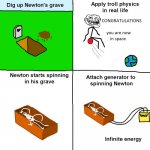no. thrust is acceleration of acceleration (unlike our game that puts limits on such things). As long as you provide thrust, you are increasing your acceleration (until you get into relativistic speeds)
F=ma, so a = F/m. The force i initially give an object of 2kg is say 1 newton. so a = 1newton / 2kg. This a is always 0.5m/s^2 unless a force changes it. Forever. a doesn't magically go to 0. It can only go to 0 if something changes it and that's impacting my target in the game. a projectile's kinetic energy is lowest at the beginning of it's journey and highest at the end (in space with no messy gravity or EM forces to interfere).
No, you're mis-using basic scientific concepts as paper planes.
Force acts on the kinetic projectile when it is fired. As soon as the <whatever> force is done firing the kinetic projectile, it does indeed go to zero.
Force doesn't "magically" continue to act on a projectile long after it has gone off on the journey it started.
Please, if every body of mass continued to accelerate indefinitely long after it was given a push, it would destroy the universe in no time.
- - - Updated - - -
Please don't feed the troll people. First graders know this stuff.
You're right.
On a lighter note, this forum member is the first to get on my Ignore List for purely scientific reasons.
Last edited:

